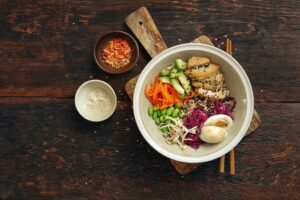
Some foods are well known for stuff unconfined protein sources: eggs, chicken, beef, fish, peanut butter, Greek yogurt and plane almonds.
But there are many lesser-known protein-packing foods to consider, like lentils, quinoa, peas, spinach, woebegone beans, chickpeas and edamame.
There’s a lot to learn well-nigh powering up with protein, which is a nutrient we need every day and one of the main towers blocks of a healthy diet.
Corewell Health dietitian Kristi Veltkamp offers protein tips–including several new, healthier ways we might consider working it into our diet.
How much protein do I need every day?
Well, it depends–on your size, gender, age, worriedness level and more.
That said, the recommended daily wage of protein for a sedentary sultana is 0.8 grams of protein per kilogram of soul weight, or 0.36 grams per pound. So, to summate your daily protein intake, multiply your weight in pounds by 0.36.
That ways that the stereotype sedentary man should eat well-nigh 56 grams of protein per day, and the stereotype woman should eat well-nigh 46 grams.
People over the age of 60, highly zippy people, and those who are trying to build muscle mass, might need more, Veltkamp said.
When should I slosh most of my protein?
Some people like to start the day with a protein-packed breakfast. Meanwhile, many Americans slosh most of their protein at dinner.
Ideally, spread it out as evenly as possible, Veltkamp said.
“Your metabolism is working all day, so we need to requite it that supply from protein. If you have little chunks of protein throughout the day, your soul can be towers and repairing all day.”
Balancing protein with carbohydrates throughout the day can moreover help you finger satisfied longer and helps wastefulness your thoroughbred sugar so you are not getting spikes, Veltkamp said.
Some ways to do that with snacks: apples with peanut butter, a trail mix of your favorite nuts or seeds with zestless fruit or visionless chocolate chips, carrots with hummus, or Greek yogurt with berries.
Can I get too much protein?
That’s complicated. Veltkamp said that most people hands get the recommended value of protein in a given day.
Consider this: the recommended portion size of meat as part of a healthy meal is 3 to 5 ounces–about the size and thickness of the palm of your hand or a deck of cards.
And that vacated is virtually 25 grams of protein–halfway to the stereotype recommended daily amount.
“We typically get that very hands and can exceed that,” Veltkamp said.
The problem comes not necessarily in too much protein, but in where that protein is coming from, she said.
“Too much protein tends to be unprepossessing protein,” she said. “It’s nonflexible to overeat when we’re eating plant-based protein.”
And too much unprepossessing protein can lead to higher amounts of cholesterol, saturated fat and calories, which leads to a higher risk of heart disease, colon cancer, stroke and diabetes, as well as other risks.
Also, glut protein is stored as fat and can lead to weight proceeds or prevent weight loss.
Meanwhile, eating increasingly plant-based foods offers benefits including maintaining a healthy weight, improved gut health, boosted immune system, reduced inflammation, increasingly vitamin and mineral content, no cholesterol, and increasingly fiber.
The biggest thing Veltkamp said she talks well-nigh with many people is eating increasingly plants.
“Make unprepossessing proteins a side item on your plate,” Veltkamp said. “Three ounces is plenty for a serving. And segregate a lean option such a poultry or seafood. Then load up increasingly on your plant intake considering that is where most of your health benefits are going to come from.”
A rule of thumb to make that easy to remember: divide your plate into one-quarter lean and healthy protein such as yellow breast, one-quarter starch or whole grain such as brown rice or baked potato, and the remaining half fill with vegetables.
What are some non-meat protein sources?
The list is long, Veltkamp said.
Consider these, listed with the value of protein per 1 cup serving:
- Chickpeas or hummus, 20 grams
- Red lentils, 18 grams
- Black beans, 18 grams
- Shelled edamame, 18 grams
- Quinoa, 16 grams
- Brown rice, 10 grams
- Green peas, 9 grams
- Spinach, 4 grams
If you’re feeling increasingly adventurous, you can turn to tofu, which offers 9 grams of protein per three ounce serving, or tempeh, which has 16 grams per three ounce serving.
Another tip from Veltkamp: total up all the protein in your meal before you add meat, and you might be surprised how much is there already.
Veltkamp pointed out that some countries’ diets–including those in places where people traditionally live the longest–are based on plant-based proteins.
And flipside bonus for going plant-based: unprepossessing protein such as meat and eggs are expensive right now.
“A can of beans is much cheaper,” she said.
It might be time to start thinking well-nigh new sources of protein and find a wastefulness that works for you.
The post Protein power 101 appeared first on Corewell Health | Health Beat.
















